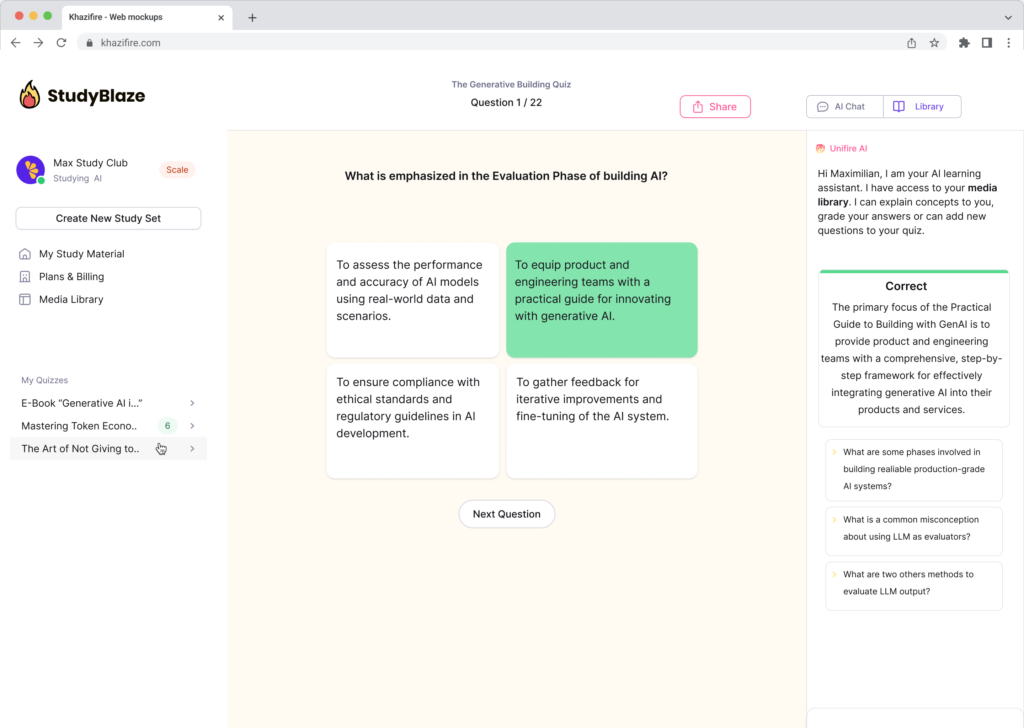Trigonometry Quiz
Trigonometry Quiz offers users a comprehensive assessment of their understanding of trigonometric concepts through 20 diverse questions that challenge their skills and knowledge.
You can download the PDF version of the quiz and the Answer Key. Or build your own interactive quizzes with StudyBlaze.
Create interactive quizzes with AI
With StudyBlaze you can create personalised & interactive worksheets like Trigonometry Quiz easily. Start from scratch or upload your course materials.

Trigonometry Quiz – PDF Version and Answer Key

Trigonometry Quiz PDF
Download Trigonometry Quiz PDF, including all questions. No sign up or email required. Or create your own version using StudyBlaze.

Trigonometry Quiz Answer Key PDF
Download Trigonometry Quiz Answer Key PDF, containing only the answers to each quiz questions. No sign up or email required. Or create your own version using StudyBlaze.

Trigonometry Quiz Questions and Answers PDF
Download Trigonometry Quiz Questions and Answers PDF to get all questions and answers, nicely separated – no sign up or email required. Or create your own version using StudyBlaze.
How to use Trigonometry Quiz
“The Trigonometry Quiz is designed to assess a participant’s knowledge and understanding of trigonometric concepts and functions. Upon initiation, the quiz generates a series of questions that cover various topics within trigonometry, such as sine, cosine, tangent, and their respective identities, as well as applications of these functions in solving triangles and modeling periodic phenomena. Each question is presented in a multiple-choice format, allowing the participant to select the answer they believe to be correct. After the participant has answered all the questions, the quiz automatically grades the responses by comparing them against a predetermined answer key. This grading process provides immediate feedback, indicating which answers were correct and which were incorrect, along with the overall score. The simplicity of this quiz generation and grading system ensures that participants can efficiently evaluate their understanding of trigonometric principles without the need for manual intervention.”
Engaging with the Trigonometry Quiz offers a multitude of benefits that can significantly enhance your mathematical skills and confidence. By participating in this interactive experience, learners can expect to deepen their understanding of trigonometric concepts, which are foundational for various fields such as physics, engineering, and architecture. The quiz provides immediate feedback, allowing individuals to identify their strengths and weaknesses, thereby enabling targeted improvement. Furthermore, it fosters critical thinking and problem-solving abilities, essential skills not only in mathematics but also in everyday decision-making. As you navigate through the questions, you’ll find your retention of key formulas and identities improving, making future applications of trigonometry more intuitive. Ultimately, the Trigonometry Quiz serves as a valuable tool for anyone looking to bolster their academic performance or simply enjoy a rewarding challenge in the realm of mathematics.
How to improve after Trigonometry Quiz
Learn additional tips and tricks how to improve after finishing the quiz with our study guide.
“To master trigonometry, it’s essential to understand the fundamental concepts and relationships between the angles and sides of triangles, particularly right triangles. Begin by familiarizing yourself with the primary trigonometric ratios: sine, cosine, and tangent. The sine of an angle is the ratio of the length of the opposite side to the hypotenuse, cosine is the ratio of the adjacent side to the hypotenuse, and tangent is the ratio of the opposite side to the adjacent side. Additionally, remember the reciprocal functions: cosecant, secant, and cotangent. Practice drawing right triangles and labeling the sides according to these relationships, as visualizing these elements will aid in comprehension and retention.
Beyond the basic definitions, it’s crucial to apply these concepts to solve problems. Work on solving for unknown sides or angles using the inverse trigonometric functions when necessary. Familiarize yourself with the unit circle, as it provides a foundation for understanding the behavior of trigonometric functions at various angles, including common angles like 30°, 45°, and 60°. Using the unit circle, you can also explore how trigonometric functions behave in different quadrants and their periodic nature. Finally, practice a variety of problems, from basic calculations to word problems, to reinforce your understanding and build confidence in applying trigonometric principles to real-world scenarios.”
